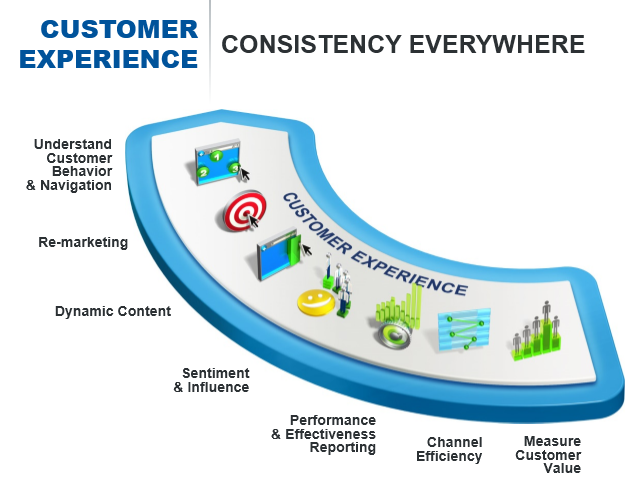Thanks for joining us for the final post in our series detailing out the Integrated Marketing Management visual that describes what it takes for marketing departments to deliver long term profitable growth to their organizations. In our previous posts we detailed the full visual, and then the first two sections of strategy & planning and orchestration & interaction.
Managing the customer experience over time is essential to long-term growth for every organization. Disillusion or alienate a customer once from your brand via a bad service experience or even a “no reply” – and they could be gone for life. Manage the customer experience correctly – by taking what you learn from customers via solicitation and feedback over various channels – and you can feed it back into future marketing initiatives to your customer segments.
Managing the customer experience properly requires consistency in interaction with the brand – so customer’s perceptions are correct. Excellent customer experience management requires knowing your customers so completely that you can create and deliver personalized experiences that will entice them to not only remain loyal to you, but also to evangelize to others about you – and word of mouth advertising is the most valuable form.
Keep reading to learn more about the capabilities in the customer experience category:

The following capabilities detail the abilities of the Adaptive Customer Experience product suite -
Understand Customer Behavior and Navigation – More commonly known at SAS as Customer Experience Analytics, this capability involves dynamic data collection at the individual customer level. The process differs from traditional web analytics tools that only collect channel data like page views, bounce, and session times. Understanding a customer’s behavior and then tying online behavior to offline data detail about a customer allows organizations to round out a customer profile for deepened customer insight – and in turn better marketing campaigns.
Re-marketing – Have you ever been to a website and looked at a certain page, received a certain banner or image based offer, or even begun a process like an application or cart checkout but not completed the task? Have you shortly thereafter received some sort of follow up message – perhaps via email encouraging you to complete said task – or even offering you something else? If you have, this is an example of re-marketing. By first understanding individual customer behavior, and then marketing to that behavior, SAS can help organizations acquire incremental revenue by encouraging customers to move down the purchasing path.
Dynamic Content – Serving personalized content into a web property based on a customer’s navigation history some may consider “creepy” – but I see it as less online hunting I have to do for a product or service. It makes sense – make the customer experience as convenient and efficient as possible – the customer gets what they want – and the organization gets what they desire as well – revenue and customer satisfaction.
Sentiment and Influence – Starting just a few years ago, social media burst on the scene as the hot topic for marketers. Everyone, everywhere wanted social media tips and tricks. Now, it has matured into another digital channel – that happens to be creating large volumes of unstructured data. Being able to extract that data, filter it, classify it, and apply sentiment and influence scoring to it – in order to use it for and in marketing campaigns is something SAS regularly helps organizations accomplish with social media analytics.
Performance & Effectiveness Reporting – Reporting on overall marketing effectiveness by measuring the performance of initiatives (e.g., whitepapers versus social media versus online programs) is done using important business metrics, such as return on marketing investment, marketing attribution and other marketing metrics. This process, often called marketing analytics, allows organizations to quantify the impact of marketing, which – in the day and age of stagnant marketing budgets – is something that CMO’s are often very interested in.
Channel Efficiency – Understanding the efficiency of marketing channels and attributing that to revenue is often the holy grail of marketing. Being able to use marketing analytics to gather data from across all marketing channels and consolidating it into a common marketing view for attribution exercises is imperative. Making decisions without a comprehensive view of all channel data can often be inadequate – and SAS’s solutions help organizations avoid doing just that.
Measure Customer Value – Understanding the value an individual customer brings to an organizations can often be very difficult. SAS – with analytical customer value calculations that are tried and true – can help organizations understand customer value at a very detail level – in order to include value scoring as a key data attribute in marketing campaigns.
So we can summarize that in today's complex marketing world, being able to derive insight from customer touch points or channels is not just recommended – it's necessary. The online channel has become one of today's fastest-growing and data-rich channels. Being able to harness the mountains of customer data coming from this channel – and then being able to extract valuable insight from the data – is mandatory for today's marketer. Feed the insights gleaned from the customer experience category back into strategy and planning to complete a true closed loop marketing process. Please keep in mind that making small changes to one or two areas can give us improved marketing results overall.
Hopefully this blog series has helped crystallize the advantage of an integrated marketing management approach. We all need to get the best possible results from our marketing initiatives and this approach has been proven to work. Would you agree? Please comment and join in the discussion! And as always, thanks for following!

1 Comment
Pingback: Customer Experience | TCELab Blog